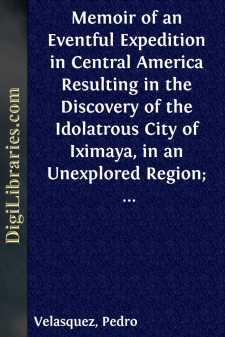Categories
- Antiques & Collectibles 13
- Architecture 36
- Art 48
- Bibles 22
- Biography & Autobiography 813
- Body, Mind & Spirit 142
- Business & Economics 28
- Children's Books 17
- Children's Fiction 14
- Computers 4
- Cooking 94
- Crafts & Hobbies 4
- Drama 346
- Education 46
- Family & Relationships 57
- Fiction 11829
- Games 19
- Gardening 17
- Health & Fitness 34
- History 1377
- House & Home 1
- Humor 147
- Juvenile Fiction 1873
- Juvenile Nonfiction 202
- Language Arts & Disciplines 88
- Law 16
- Literary Collections 686
- Literary Criticism 179
- Mathematics 13
- Medical 41
- Music 40
- Nature 179
- Non-Classifiable 1768
- Performing Arts 7
- Periodicals 1453
- Philosophy 64
- Photography 2
- Poetry 896
- Political Science 203
- Psychology 42
- Reference 154
- Religion 513
- Science 126
- Self-Help 84
- Social Science 81
- Sports & Recreation 34
- Study Aids 3
- Technology & Engineering 59
- Transportation 23
- Travel 463
- True Crime 29
Memoir of an Eventful Expedition in Central America Resulting in the Discovery of the Idolatrous City of Iximaya, in an Unexplored Region; and the Possession of two Remarkable Aztec Children, Descendants and Specimens of the Sacerdotal Caste,...
by: Pedro Velasquez
Categories:
Description:
Excerpt
The above three figures, sketched from engravings in “Stevens’s Central America,” will be found, on personal comparison, to bear a remarkable and convincing resemblance, both in the general features and the position of the head, to the two living Aztec children, now exhibiting in the United States, of the ancient sacerdotal caste of Kaanas, or Pagan Mimes, of which a few individuals remain in the newly discovered city of Iximaya. See, the following Memoir, page 31.
These two figures, sketched from the same work, are said, by Senor Velasquez, in the unpublished portion of his narrative, to be “irresistible likenesses” of the equally exclusive but somewhat more numerous priestly caste of Mahaboons, still existing in that city, and to which belonged Vaalpeor, an official guardian of those children, as mentioned in this memoir. Velasquez states that the likeness of Vaalpeor to the right hand figure in the frontispiece of Stevens’ second volume, which is here also the one on the right hand, was as exact, in outline, as if the latter had been a daguerreotype miniature.
While writing his “Narrative” after his return to San Salvador, in the spring of the present year, (1850,) Senor Velasquez was favored, by an American gentleman of that city, with a copy of “Layard’s Nineveh,” and was forcibly struck with the close characteristic resemblance of the faces in many of its engravings to those of the inhabitants in general, as a peculiar family of mankind, both of Iximaya and its surrounding region. The following are sketches, (somewhat imperfect,) of two of the male faces to which he refers:
And the following profile, from the same work, is pronounced by Velasquez to be equally characteristic of the female faces of that region, making due allowance for the superb head dresses of tropical plumage, with which he describes the latter as being adorned, instead of the male galea, or close cap, retained in the engraving.
These illustrations, slight as they are, are deemed interesting, because the Iximayans assert their descent from a very ancient Assyrian colony nearly co-temporary with Nineveh itself—a claim which receives strong confirmation, not only from the hieroglyphics and monuments of Iximaya, but from the engravings in Stevens’ volumes of several remarkable objects, (the inverted winged globe especially,) at Palenque—once a kindred colony.
It should have been stated in the following Memoir, that Senor Velasquez, on his return to San Salvador, caused the two Kaana children to be baptized into the Catholic Church, by the Bishop of the Diocese, under the names of Maximo and Bartola Velasquez.
MEMOIR
OF A RECENT
EVENTFUL EXPEDITION
IN
CENTRAL AMERICA.
In the second volume of his travels in Central America—than which no work ever published in this country, has created and maintained a higher degree of interest, both at home and abroad—Mr. Stevens speaks with enthusiasm of the conversations he had held with an intelligent and hospitable Padre, or Catholic priest, of Santa Cruz del Quiche, formerly of the village of Chajul; and of the exciting information he had received from him, concerning immense and marvellous antiquities in the surrounding country, which, to the present hour, remain entirely unknown to the world. The Padre told him of vast ruins, in a deserted and desolate region, but four leagues from Vera Paz, more extensive than Quiche itself; and of another ruined city, on the other side of the great traversing range of the Cordilleras, of which no account has been given....


